Flyer (pamphlet)
This article includes a improve this article by introducing more precise citations. (August 2011) ) |

A flyer (or flier) is a form of
Terminology
A flyer is also called a "palm card",[1] "circular", "handbill", "pamphlet", "poster", "lit'" (literature), "weekly ad", "catalogue" or "leaflet".[citation needed]
Usage
Flyers may be used by individuals, businesses, not-for-profit organizations or governments to:
- Advertise an event such as a music rally
- Promote a massage parlour.
- Persuade people about a social, religious, or political message, as in evangelism or political campaign activities on behalf of a political party or candidate during an election. Flyers have been used in armed conflict: for example, airborne leaflet propaganda has been a tactic of psychological warfare.
- Recruit members for organizations or companies.
Like postcards, pamphlets and small posters, flyers are a low-cost form of mass marketing or communication. There are many different flyer formats. Some examples include:
- A4 (roughly letterhead size)
- A5 (roughly half letterhead size)
- DL (compliments slip size)
- A6 (postcard size)
Flyers are inexpensive to produce and they required only a basic
Flyers are not a new medium: prior to the
In the 2000s, some jurisdictions have laws or ordinances banning or restricting leafleting or flyering in certain locations. Owners of private property may put up signs saying "Post No Bills"; this occurs particularly on wooden fences surrounding building sites or vacant lots.
Distribution and use
Flyers are handed out on the
In the 2010s, some individuals and organizations send flyers through
-
Distribution of leaflets over Afghanistan by the U.S. military in 2010
-
Flyers pasted to a wall inChina
-
Common Sense was a pamphlet that was distributed preceding the American Revolution
See also
References
- US House of Representatives: History, Art & Archives. Retrieved 22 April 2023.
- Ackland-Snow, Nicola & Brett, Nathan & Williams, Steven. Fly: The Art of the Club Flyer. Watson-Guptill Publications, 1997. ISBN 0-8230-1854-7
- Searching for the Perfect Beat: Flyer Designs of the American Rave Scene. Watson-Guptill, 2000. by The Earth Program (Author), Neil Strauss (Introduction). ISBN 0-8230-4751-2
- Barcelona Club Flyers (Actar Publishing, 1999), by Tite Barbuzza (Contributor), Joan Manel Jubany (Contributor), Albert Masferrer (Contributor), Yolanda Muelas (Contributor), ISBN 84-89698-25-2
- Büru Destruct (Consortium Book Sales & Dist, 1999), By Büru Destruct, ISBN 3-931126-24-2
- Clubspotting (Happy Books, 2000), by Paolo Davoli & Gabriele Fantuzzi, ISBN 88-86416-24-5
- Design After Dark: The Story of Dancefloor Style (Thames and Hudson, London, 1991), by Cynthia Rose, ISBN 0-500-27648-X
- Design Agent 007: License to Design DGV. Die gestaften Verlag, Berlin 2002. ISBN 3-931126-14-5
- Event Flyer Graphics. Nippan/Biblios, 2001. ISBN 3-910052-75-4
- Flyer Soziotope: Topography of a Media Phenomenon. (Archiv der Jugendkulturen (G)/Actar (ES), 2005), German-English and English-German. ISBN 84-96540-03-0
- Klanten, Robert & Peyerl, Andreas & Hollmann-Loges, Markus: Flyermania: European Flyers. Art Books Intl Ltd, 1998. ISBN 3-931126-15-3
- Highflyers: Clubravepartyart. By 3 Beat Music. Booth Clibborn Editions, London, UK, 1995. ISBN 1-873968-78-7
- Beddard, Phil: Nocturnal: Global Highflyers. Booth-Clibborn, 2000. ISBN 1-86154-169-4
- Jordan, Joel T. et alii: Searching for the Perfect Beat: Flyer Designs of the American Rave Scene. Watson-Guptill Pubns, US, 2000. ISBN 0-8230-4751-2
External links
 Media related to Hand bills at Wikimedia Commons
Media related to Hand bills at Wikimedia Commons




